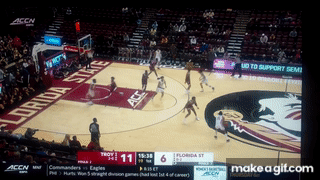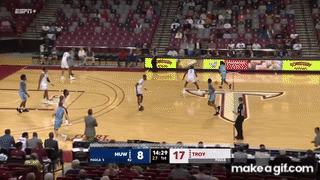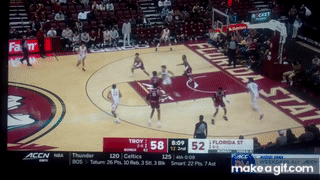Arkansas returns from a successful trip to Maui to take on Troy on Monday night. The Trojans are 6-1 and their only loss was by two points, but they’ve also played one of the weakest schedules in the country. While Troy’s defense may present some problems for the Razorback offense, the Hog defense has an extremely friendly matchup on their hands.
Meet the Trojans
Scott Cross is best known for his long stint as UT Arlington’s head coach, bringing the Mavericks from the Southland to the Sun Belt for basketball during his time from 2006 to 2018, winning 225 games. After UTA went 21-13 (10-8) in 2018 – leaving Cross with three straight 20+ win seasons and a 37-19 Sun Belt record over that span – UTA suddenly fired him, with the athletic director citing the need for “new leadership.”
It will probably not surprise you to hear that the AD botched the next hire and UT Arlington is now terrible at basketball, while Cross’s rebuild of Troy has not taken long. The Trojans won 20 games last year – Cross’s third season – and are expected to be one of the better teams in the Sun Belt this season.

Okay, I know what you’re thinking. Yes, Mississippi University for Women is real. No, Troy’s men’s team did not play a college basketball game against women. Despite the name, this Division III school does admit men and its student body is about 20% male.
Anyway, the feather in the Trojans’ cap is that 79-72 win against Florida State. The Seminoles are 1-6 and have also lost to Siena and Stetson, but that’s a nice win if in name only.

I’m not actually sure what caused Arkansas to dip from 22nd to 35th since Wednesday morning’s stat run. The model now says Arkansas would perform worse against all six opponents they’ve played so far than they actually did: for instance, it says the Hogs would beat Louisville by 22 points on a neutral floor, when Arkansas in fact won by 26 on a neutral floor. It may be that the Dakota schools are off to a slow start (due to tough scheduling) and that will even itself out over the season.
Anyway, model pick: Arkansas 75, Troy 58.
When Troy has the ball

The old days of Don Maestri’s high-flying Troy State teams, like the 1992 team that beat DeVry 258-141 in the highest-scoring game in NCAA history, are long gone now. The modern Trojans play at a very deliberate pace and aren’t great on offense.

Troy actually has a pretty good halfcourt offense, but they make things hard for themselves by getting nothing from transition. The Razorbacks’ transition defense has been solid to start the year, but outside of the Creighton game, the halfcourt defense has also been great.

Troy’s “decent in halfcourt” thing is pretty simple: they don’t turn the ball over. Not turning it over means they get a shot on almost every possession. Do those shots go in? Not really. The Trojans take way too many midrange jumpers and don’t finish at the rim well at all. They aren’t a bad 3-point shooting team, but they don’t generate a lot of open looks.
This seems like a friendly matchup for Arkansas’ defense. The Hogs’ main weakness is that they are allowing too many shots at the rim, and Troy is not well-suited to exploit that.
Personnel

Important note: our numbers will look very different from the numbers you’d see on a normal site. That’s because we don’t use non-D1 games in any stats anywhere on the site, and Troy has played three such games.
The Trojan offense is run through 6’1 point guard Aamer Muhammad, a transfer from Division II Lubbock Christian. Muhammad is mostly a distributor, although he can knock down a 3-pointer if left open. He leads the team in assists and is decent at taking care of the basketball.
The scoring will primarily come from the other four guards in Troy’s deep roster. The two really efficient ones are 6’5 Kieffer Punter and 6’3 Christyon Eugene. With grades of 93 and 91 for the season, the numbers say these are two of the better guards the Hogs have seen all season. Punter forces turnovers and makes a living at the free throw line, where he shoots more than 90%. Eugene never turns the ball over and is a decent 3-point threat.
While Punter and Eugene are very efficient, the Trojans will get volume from 6’2 Duke Miles and 6’3 Nelson Phillips. Miles’ best two games were against non-D1 opponents. Against Division I opponents, he’s a slightly-below-average shooter who is a bit turnover-prone. Phillips doesn’t turn it over at all and is a great rebounder but is the worst-shooting guard in the regular rotation.
You’ll probably notice that isn’t much size, and the Trojans are indeed very small. Their lone starting forward is 6’9 Zay Williams, who is a decent shooter, good rebounder, and pretty good at protecting the ball. At only 190 pounds, he’s going to have a hard time defending the paint by himself. The Hogs’ size seems likely to overwhelm the Trojans, which would force them to use their other forward, 6’7 Christian Turner. Turner isn’t a great rebounder but he shoots a good percentage, including from beyond the arc.
Arkansas is still searching for a good option at the 5 between Makhi Mitchell, Makhel Mitchell, and Kamani Johnson. This is not a matchup where the Hogs need to have that figured out.
When Arkansas has the ball
The Trojans have prepared an unpleasant defense for the Hogs: the no-middle. Oh yes. It’s the trendy defense in college basketball. If the Hogs want to have a good season, they’ll need to get through several no-middle defenses both in the regular season and the NCAA Tournament.
Essentially the entire Big 12 now runs it (all of those pictures are of teams running no-middle):
So what is the no-middle? You can read a longer version of the background in one of our Texas A&M previews from last year, as Buzz Williams runs it with the Aggies, but here’s the basic background: the early principles developed in the NBA after the elimination of the “illegal defense” rule, which forced teams to play strict man-to-man. Teams began “icing” ball screens – stepping in front of the screen to prevent the ball handler from using it – to keep the ball on one side the floor, where they could send help defense and trap the ball against the sideline, something that had previously been illegal.
Here’s Troy icing a ball screen against Florida State, keeping the ball on the left side:

Icing ball screens and trapping the ball on one side became all the rage, until NBA offenses figured out that a crosscourt pass (known as a “skip pass” because it “skips” the nearest offensive player) could lead to an open catch-and-shoot 3-pointer. If you’ve ever been tempted to blame Steph Curry for the massive rise in 3-point shooting in the NBA over the last decade-plus, think again: blame the defenses that developed out of the end of the illegal defense era.
Even if NBA players can shoot a defense like this out of the gym… can college players? A Division II coach and his assistant didn’t think so. Chris Beard and Mark Adams took “trapping the ball to one side” to the extreme, creating the no-middle defense, a defense entirely built around keeping the ball out of the middle. Beard and Adams were hired at Little Rock, where they made some history in their only season:

Beard is now at Texas and Adams at Texas Tech, where they have a fierce rivalry. Baylor adopted the no-middle last season, as did Texas A&M. It’s even filtered down to Troy, and the Hogs will probably see it many more times as more and more teams implement it.
The no-middle starts with the defense shading to the middle. Here, the Mississippi University for Women point guard (I can’t believe there are highlights of this) goes right, so Troy’s on-ball defender stands between him in the middle of the floor, forcing him to go along the sideline:

Notice how all five defenders are to the right side of the floor. The ball can’t get back to the middle, and any attempt to get down to the post will draw an immediate double-team. A skip pass might lead to an open 3, but it also could be intercepted:

The no-middle is not easy for Arkansas’ offense, as the Hogs are not good at catch-and-shoot 3-pointers. The Hogs were blasted by Texas in an exhibition game this year and lost twice to Texas A&M last year. The good news is that these Hogs have better personnel to deal with a no-middle, especially one from Troy.
Here’s how the Hogs have attacked a no-middle before:

A couple notes: the Hogs are in a 5-out look, meaning there are no true post players here. That’s the very modern “positionless” basketball that helped NBA teams shoot the pure no-middle out of the league. The Hogs use Jaylin Williams as a middle man on a pass to reverse the ball, then have him set a screen, then have him set up at the top of the key to receive a high-post entry pass. The no-middle hates high-post entry passes, as they give the offense a ton of passing options, but if you have a good enough passing big, they will be hard-pressed to deny it. Also, note that the Hogs have players in each corner. An entry pass followed by a kickout to the corner is always going to be an option against this look.
Whomever of Anthony Black and Ricky Council that isn’t running point will likely occupy the corner in the halfcourt. Council may make more sense here. Devo Davis would be in the other corner, although this would be an ideal game for Nick Smith to return, as he would add a ton of value on the perimeter. After that, it’s about probing the defense, making good passes and cuts, and maintaining good spacing. You can’t make dangerous passes, set moving screens (that’s an issue for many teams against a no-middle), or get too 3-point happy.

Troy’s no-middle is fine for its level, but it’s hardly elite. This is probably going to be more of a test for the Hogs to see how they do against a trendy scheme.

Troy has had some issues getting beat down the floor before they can set up their defense, so the Hogs will probably have some opportunities to run. The Razorbacks’ halfcourt offense was much better in Maui, but still is far from where it needs to be for the Hogs to be a title contender. For now, Arkansas gives itself a better chance by getting in transition.

The Trojans are very good at denying shots at the rim and clearing defensive boards. Because of their lack of size, they’ve had to foul like crazy to prevent those rim shots (315th in free throw rate) and opponents who get to the rim usually score (277th in rim field goal defense). They’ve also been scorched from beyond the 3-point arc, as their aggressive defense can be pretty easily out-spaced by a competent perimeter team.
It’s true every game, but it’s definitely true against this defense that the Hogs cannot settle for long jump shots. Getting to the rim against a defense like this isn’t easy, but they’ll be rewarded if they can do it.
Keys to the Game
- Get to the rim. Arkansas might can win this game with a barrage of 3-pointers, but that’s never a risk you want to take, especially when Troy is going to have to hack like crazy to prevent the Hogs from living in the paint. A good day for the Razorbacks would be 35 free throws or more.
- Don’t foul more than necessary. While Troy’s defense might be tricky, the Hogs have to love the matchup against the Trojan offense. Troy is quite bad in all the metrics that scare Arkansas: they don’t get many open 3-point shots, they don’t finish at the rim, and they don’t crash the offensive glass very well. Their only real chance is to draw some fouls, which they are decent at doing.
Thanks for reading! Be sure to follow us on Twitter.
The latest from Fayette Villains, straight to your inbox
Enter your email to subscribe and receive new post alerts and other updates. You can unsubscribe at any time.